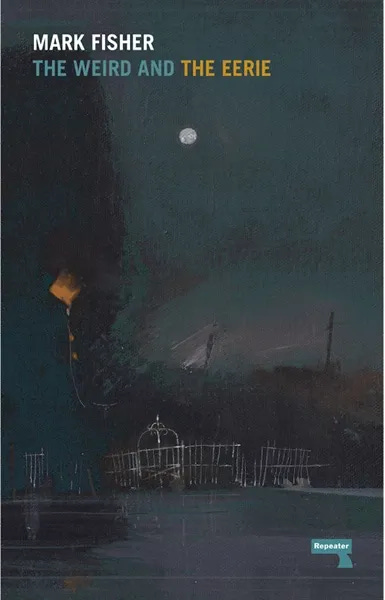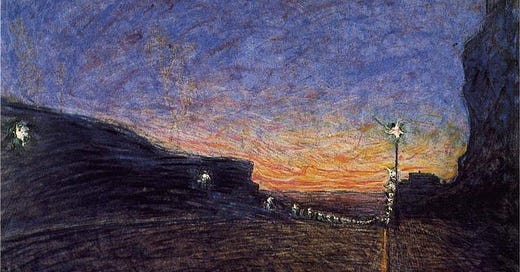Under the Sign of the Weird
Part 2 of my review-essay on Knausgaard's The Third Realm/Morgenstjernen; Mark Fisher, A Time for Everything and laughter
<Previous>
It is the irruption into this world of something from outside which is the marker of the weird.1
In his final book, The Weird and the Eerie, Mark Fisher explicated two separate yet related modes of the strange, which, he explains, is marked by “a fascination for the outside, for that which lies beyond standard perception, cognition and experience.”2
At the risk of being too denotative when talking about a subject whose very nature is ambiguity, it could be said that the weird is the positive presence of the strange, whereas the eerie is a presence or absence itself as strange.

The weird, as elucidated by Fisher, is an appearance that we perceive as having a “sense of wrongness” about it. “[T]he conviction that this does not belong” is “often a sign that we are in the presence of the new.”3 Any confrontation with the new in the guise of the weird has an indeterminate, vacillating relationship with pleasure and displeasure—if anything, Fisher states, “there is an enjoyment in seeing the familiar and the conventional becoming outmoded [...].”4
The eerie, on the other hand,
concerns the most fundamental metaphysical problems one could pose, questions to do with existence and non-existence: Why is there something here when there should be nothing? Why is there nothing here when there should be something? The unseeing eyes of the dead; the bewildered eyes of an amnesiac—these provoke a sense of the eerie, just as surely as an abandoned village or a stone circle do.5
The star in Knausgaard’s Morgenstjernen, then, which rises on a summer night, is weird (the appearance of a strange object) but casts an inescapable field of eeriness across the world over which it rises—there is nothing, however normal, under the new star that does not become eerie; a house cat, a hotel, a deer, the neighbors’ living room lights, the evening news, dinner with the kids, and on and on. Everything in normal life takes on the pale glow cast by the star, an object intruding on the world from the outside. The nature of this outside is a great point of speculation and unease for Morgenstjernen.
The weird, I think, can still have something funny about it, but the eerie does not seem to evoke laughter. It can be laughter,6 but funny, it is not.
There is the famous Freudian truism that we laugh at jokes because they momentarily depose an authority. Our laughter is an outburst of joy, a kind of sympathy with destituent violence inflicted against the rule of the symbolic.
So, the weird, which, as Fisher states, outmodes the familiar and conventional—the two most elemental and depersonalized authorities—is liable to make us laugh, even if such laughter has something nervous about it.
Nervous laughter has a place in Morgenstjernen. Certain characters (whichever the reader identifies with) evoke it in moments of relief. The characters themselves laugh and chide each other about the new star in the sky and their respective hypotheses about its nature, but the phenomena seemingly connected with it, the sights and visions, the perhaps satanic killings, what we might call high eeriness—none of this evokes laughter (just one metric that signals the eerie).
The eerie has taken over for the weird when things stop being funny.7
The eerie is also marked by absence. The weird is an overdetermination, an overflow of significance out of place in an object—and this describes the star in Morgenstjernen quite well. So, how to account for the eerie feeling of absence throughout the book? Is it the absence of an explanation of the new star? I don’t think so. This is too abstract to be effective at the “reality level” of the text.
The most conspicuous absence is made explicit in the epigraph of The Morning Star, taken from Revelation:
And in those days shall men seek death, and shall not find it; and shall desire to die, and death shall flee from them.
And yet, as with epigraphs, which hover ambiguously over the texts they precede and may be read any number of ways, it leaves us wondering how literally we are to understand this absence of death—because the violence that deals death and the signs, often terribly grotesque, that signal its imminence, are constantly present.
The ultimate example of this is the ostensible killing and mutilation in the woods of the black metal band Kvitekrist, a main point of departure for the novel cycle. Geir, a kind of soft neo-noir cop, investigates the ostensible killings, delves into video of the scene taken before the act and interviews potential witnesses. But the compelling part is the contrast between Geir’s everydayness (under the sign of the weird) and the overwhelming eeriness of what we the readers suspect from the epigraph, namely, that nothing and nobody in the book, from the time the star appears in the sky, can die. This is the constant bite of the eerie.
A Time for Everything: the first book of Morgenstjernen?
Earlier this summer, I read book two of Morgenstjernen, The Wolves of Eternity. But just before this, I also read Knausgaard’s 2004 novel A Time for Everything, a reframing of the early books of the Bible in fjords and green fields (imagine if the story of the flood were written in the style of Hamsun’s The Growth of the Soil) within the Italian 16th-century frame-narrative of Antinous Bellori.
As a boy, Bellori encounters two angels fishing in a forest river. It affects him deeply, and he dedicates his life not only to theology and the study of angels but to finding them again in the flesh. Eventually, a melancholy and theologically frightening theory of angels is presented: they are trapped in the world and are slowly dying. Once, in medieval times (the Second Realm of Biblical time), there were many sightings of angels, but even this was a period of decadent spectacle, a sign of their increasing isolation and powerlessness and separation from the divine. They no longer fell in love with human women or slew men, as in the Old Testament (or the First Realm of Biblical time). The angels became atomized, feral, and slowly began to die.
It is almost impossible for me not to locate A Time for Everything, especially with the appearance of The Third Realm, as a kind of unofficial first book of Morgenstjernen. I wouldn’t be surprised in the least if it were republished accordingly, like how The Hobbit is sometimes included as the first book in Lord of the Rings.
In A Time for Everything, the angels are the concentration of weirdness that casts the spell of eeriness over the world: forests, mountainsides, harbors, farmland, market squares and, most significantly, people; all uncanny outgrowths of life, ignorant that their entire existence takes place in the walls of a prison the sole function of which is to keep divinity from returning to itself.
This is a pure eeriness of subjectivity, fundamentally alien to itself, cut off from any possibility of foundation, ground or wholeness.
In Morgenstjernen, there are no clear angels as in A Time for Everything, except for the morning star itself, the “shining one” —Lucifer, who undergoes (or initiates?) a profound development in The Third Realm.
<Next>
Mark Fisher, The Weird and the Eerie, Repeater Books. 8.
Ibid. 20.
Ibid. 13.
Ibid.
Ibid.
This section, only up to this point, is a near-direct recapitulation of an unpublished essay of mine on the eerie dimension of the crowd, “Eerie Sublimity,” from a longer project called On the Aesthetic Dimension of Crowds.
Laughter takes up the role of “an irruption” or “something from outside”, thus aping the logic of the weird—when it isn’t contagious but isolated, it becomes eerie. (Laughter remains more or less weird if it makes us laugh too, but it becomes eerie within the disconnect between the sound of laughter and the silence provoked in ourselves, who cannot understand this alienated/alienating laughter’s cause.)
I think of watching Courage the Cowardly Dog as a little kid. Most of the humor in the show ranges from standard cartoon slapstick to heavy weirdness. I remember thinking the weird characters were, for all their strangeness, still funny. Courage himself is a little weird, his owners are weird, and their humorous charge certainly operates in tandem with weirdness. But the landscapes in which Courage finds himself, the music, the appearance or disappearance of certain entities—things that do not have the same status as “characters”—none of these were ever funny to me. They scared me. And they were always the eeriest, most fascinating and charged parts of the show.






